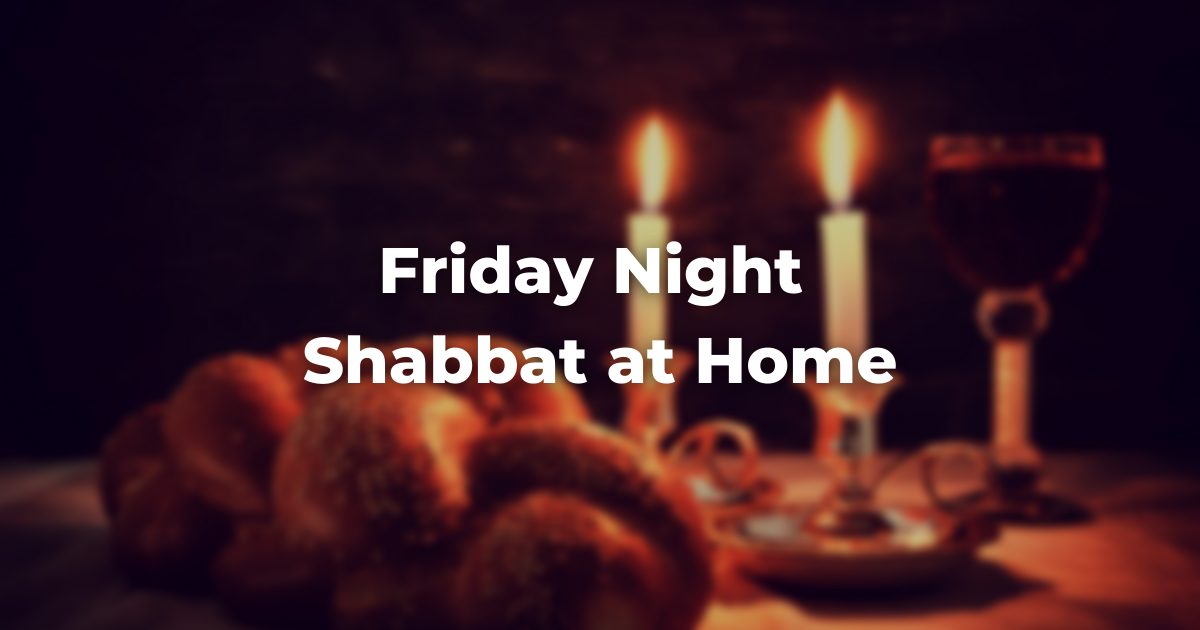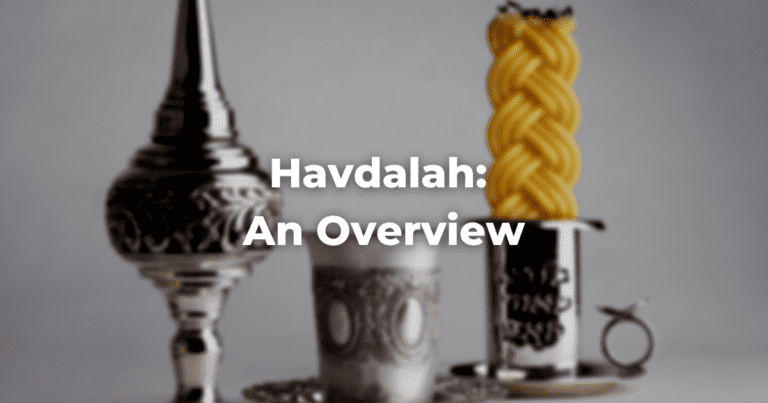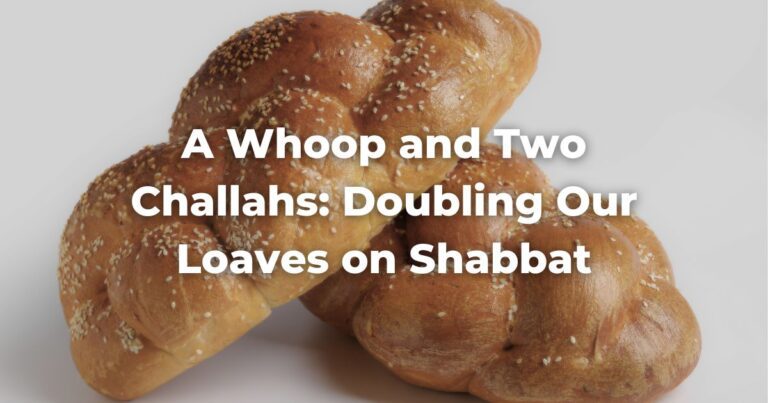Shabbat meals at home are about much more than just food. Prayers, rituals, songs, and words of TorahRefers to the first five books of the Hebrew Bible, the Tanakh, also called the Five Books of Moses, Pentateuch or the Hebrew equivalent, Humash. This is also called the Written Torah. The term may also refer to teachings that expound on Jewish tradition. Read more combine to create a unique experience rich in symbolism and meaning.
Although far less structured than, say, a Passover seder, the three Shabbat meals—Friday night dinner, Saturday lunch, and the third meal (called either se’udah sh’lishit (seudah shelishit) or, far more colloquially, shalashudis or shalshudis)—have their own programmatic order.
Blessing of Children
On Friday evenings, we begin with the blessing of children. Traditionally, the parent places their hands on the child’s head, then proceeds with a different opening prayer for boys and girls, then with a common prayer for all children.
For boys, the parent begins with the prayer that God make the boy “like Ephraim and Manasseh.” This was Jacob’s blessing for his grandsons, Joseph’s two boys, as recorded at Genesis 48:20. Even though Ephraim and Manasseh are not well-known biblical figures, we refer to them as the model sons we hope our boys grow up to be because of Jacob’s specific remark in their regard, “By you [i.e., by using your names] shall Israel invoke God’s blessing, saying, ‘[May] God make you as Ephraim and as Manasseh.’”
One commentary explains the significance of Ephraim and Manasseh as role models for us by noting that, though they grew up as members of a tiny minority in a much larger culture, they managed nevertheless to remain faithful to their family’s religious traditions. So may we, we pray, by invoking their names, and so may our sons.
For girls, the parent begins, “May God make you like Sarah, Rebecca, Rachel, and Leah.” These four women, the matriarchs of the Jewish people, raised the first generations of the Jewish people. Although this blessing does not correspond to a specific scriptural injunction like the blessing for boys does, it has its own roots in the Bible, as at Ruth 4:11, where Ruth herself is blessed that she be like Rachel and Leah, who together “built up the House of Israel.”
For all children, parents continue with the priestly benediction found at Numbers 6:24–26:
“May the Eternal bless you and protect you! May the Eternal deal kindly and graciously with you! May the Eternal grant divine favor upon you and thus grant you peace!”
Although the Bible presents these words as a special blessing transmitted by the priests of old to the people, it is customary for others to recite it in certain contexts. By using these words to bless their sons and daughters, parents acknowledge that they are the agents, not the source, of God’s blessing in their children’s lives, just the kohanim in Temple times were the transmitters, not the originators, of the blessings they offered the people.
Many use this opportunity to add personal prayers or meditations for their children. The following, taken from the second edition of Siddur Sim Shalom, are worthy examples.
For boys, one could say:
“May you be blessed by God as were Ephraim and Manasseh, who understood that wherever they lived, their Jewishness was the essence of their lives; who loved and honored their elders and teachers; and who cherished one another without pettiness or envy, accepting in humility the blessings that were theirs.”
For girls, the following would be highly appropriate:
“May God bless you with the strength and vision of Sarah, with the wisdom and foresight of Rebecca, with the courage and compassion of Rachel, with the gentleness and graciousness of Leah, and their faith in the promise of our people’s heritage.”
Click here for The Rabbinical Assembly’s Children Blessing One-Pager
Shalom Aleikhem
As the diners take their places around the table, the hymn Shalom Aleikhem (also spelled Shalom Aleichem) is sung aloud. Based on a teaching preserved in the TalmudReferring to one of two collections, the Jerusalem and Babylonian Talmuds, edited in the 6th century, that contains hundreds of years of commentary, discussion, and exploration of the ideas in the Mishnah. One could describe it as Mishnah + Gemara = Talmud Read more at Shabbat 119b, the song supposes that two ministering angels accompany worshipers home from the synagogue each Friday night.
“If they find candles lit and the Shabbat table set,” the text in the Talmud reads, “the good angel says: ‘May it be God’s will that there be another Shabbat like this one,’ and the wicked angel is forced against his will to say ‘Amen.’”
The inverse, however, is also true: if there are no signs of a traditional Shabbat in the home, the wicked angel prays that it ever be thus and the good angel is obliged to respond with an a begrudging amen. It is to these angels that diners seated at the Shabbat table sing the hymn Shalom Aleikhem.
Click here for The Rabbinical Assembly’s Shalom Aleichem One-Pager
Eishet Hayil and Honoring Partners
After Shalom Aleikhem, there is a custom that partners traditionally sing or recite the Eishet Hayil (also spelled Eshet Chayil) passage (taken directly from Proverbs 31:10–31) to their wives. Rooted in a tradition that women prepared the home, it was a way of acknowledging and praising the women who work so hard to prepare Shabbat, to run the household, and to raise their children. Today, we know that anyone and everyone has a role to preparing for Shabbat.
Popularly translated as “A Woman of Valor,” some take the Eishet Hayil as an allegory about Shabbat and the nurturing role “she” plays in a traditional Jewish home even though the simpler way to understand the text is as a partner’s ode to their wife’s virtues.
In the spirit of egalitarianism, the second edition of Siddur Sim Shalom suggests Psalm 112:1–9 as a parallel passage partners might wish to recite to their husbands.
Kiddush
Shabbat dinner begins formally with the recitation of the Kiddush over a full cup of wine.
Popularly called “making Kiddush,” the act of sanctifying Shabbat by blessing God as the Creator of “the fruit of the vine” is rooted in the biblical conception of wine as an agent of joy.
The psalmist (at Psalm 104:15) wrote that “wine . . . cheers the human heart” and so a cup filled to the brim with sweet wine has come to suggest the abundance of God’s blessings in a family’s life. The text may be found in any edition of the prayerbook.
One may recite Kiddush over grape juice instead of wine. In the absence of either, however, one makes Kiddush over the challot instead (SA Orach Chayyim 289). If doing so, however, the blessing over bread should be used to begin the prayer instead of the blessing over wine.
Some people stand for Kiddush, but others sit as it is recited. Either is considered an acceptable practice (gloss of the Rema to SA Orach Chayyim 271:10).
At home, Kiddush begins with an introductory paragraph, Genesis 2:1–3. There is, however, a widespread custom to begin not with the opening words of that first verse, but with the last words of the previous chapter of Genesis. By doing so, the worshiper begins with four words, the initial letters of which spell out the four-letter name of God. In this subtle way, God’s blessings on a Jewish home are invoked.
Hand-washing
Prior to reciting the blessing for bread, we perform the ritual washing of the hands known as n’tilat yadayim. Rings are removed so that the water comes in contact with all parts of the hands, then a vessel is filled with water.
The water is poured over the right hand and then over the left hand at least twice, although some follow the custom of pouring water three times over each hand. The following blessing is recited and then hands are dried:
בָּרוּךְ אַתָּה ה’, אֱלֹהֵינוּ מֶלֶךְ הָעוֹלָם, אֲשֶׁר קִדְּשָׁנוּ בְּמִצְוֹתָיו וְצִוָּנוּ עַל נְטִילַת יָדַיִם.
Barukh atah Adonai, Eloheinu, melekh ha-olam, asher kidd’shanu b’mitzvotav v’tzivvanu al n’tilat yadayim
Praised are You, Adonai, our God, Sovereign of the universe, who, sanctifying us with divine commandments, has commanded us concerning the washing of the hands.
The purpose of washing our hands in this peculiar way is not specifically hygienic. (Indeed, people should certainly wash their hands with soap and water before n’tilat yadayim if their hands are dirty.) After the destruction of the Temple, the Jewish house took the place of the ancient sanctuary and, in many ways, the Shabbat and festival table became latter-day substitutes for the altar.
Click here for The Rabbinical Assembly’s Handwashing One-Pager
Bread and Motzi
We wash our hands before eating bread today just as the priests washed their hands and feet before commencing the sacrificial service in ancient times.
On Shabbat, two loaves, or two rolls, are placed on the table. Traditionally, a rich egg bread known popularly as challah is used, but any kind of kosher bread may be used in its stead. The two loaves represent the double portion of manna the Israelites gathered each Friday during their forty years of wandering in the desert, as related at Exodus 16:22.
The loaves are covered by a cloth during the recitation of Kiddush (SA Orach Chayyim 271:9).
One explanation for this is that the tablecloth and the challah cover symbolize the two layers of dew that protected the manna from the desert sand. Another reason we cover the challah is to prevent it from being “jealous” that the rituals for the wine come prior to those for the bread.
This may sound just a bit far-fetched, but it masks a profound lesson: if we are bidden to be sensitive to the “feelings” of inanimate objects, then how much the more so must we be sensitive to the feelings of human beings!
From the time of the washing of the hands until the blessing over the bread, we remain silent unless the words we speak are directly relevant to the situation. Some people use these moments to hum a melody, thus focusing the attention of those present on the rituals at hand.
The cloth is then removed, the two loaves are raised, and the following blessing over bread is recited (SA Orach Chayyim 274:1):
בָּרוּךְ אַתָּה ה’, אֱלֹהֵינוּ מֶלֶךְ הָעוֹלָם הַמּוֹצִיא לֶחֶם מִן הָאָרֶץ.
Barukh attah Adonai, Eloheinu, melekh ha-olam, hamotzi lechem min ha’aretz.
Praised are you, Adonai our God, Sovereign of the Universe, who draws forth bread from the land.
The loaves are cut, sprinkled with salt, and distributed to those assembled.
What is the point of the salt? Salt was added to each offering in the Temple, as noted at Leviticus 2:13. We sprinkle salt on our bread to remind us that we are gathered in holy space, that our tables today are the equivalent of the altar of ancient times, and that a Shabbat meal is an occasion for worshiping God.
There are some variant customs in widespread use. Some pour salt onto the breadboard and then dip the bread into the salt. Others use the knife to make an impression on the bread, and then tear it by hand.
Click here for The Rabbinical Assembly’s Handwashing One-Pager
Z’mirot and Grace After Meals
In addition to the special foods on the menu, it is traditional to sing special table songs, popularly called z’mirot (also spelled zemirot), during the course of the meal. The meal, relaxed and convivial, is thus a time for family members to enjoy each other’s company.
The Grace after Meals is recited in its customary place. On Shabbat, there are significant variations and additions to the standard weekday version.
For example, the recitation begins with Psalm 126, and a special prayer for Shabbat is added in the third section of the Grace just prior to the blessing for the restoration of Jerusalem. Then, toward the end of the Grace, a special prayer, beginning with the word ha-rachaman (“The Merciful One”), is added to the other lines that begin with that same word as a tribute to Shabbat and the role it plays in Jewish life.
Finally, following the last ha-rachaman, the usual word magdil is changed to its biblical variant, migdol. This verse comes from one of those rare chapters of Scripture that appears twice in our edition of the Hebrew Bible, once as Psalm 18 and once as Samuel II 22.
On weekdays, we use the version that appears in the psalm, but on Shabbat and festivals we use the version that appears in Second Samuel. Instead of choosing one source over the other, both versions were incorporated into the liturgy. This act of accommodation and inclusion is a typically Jewish approach to textual variation.
Adapted with permission from The Observant Life.
Authors
-

The Observant Life: The Wisdom of Conservative Judaism for Contemporary Jews distills a century of thoughtful inquiry into the most profound of all Jewish questions: how to suffuse life with timeless values, how to remain loyal to the covenant that binds the Jewish people and the God of Israel, and how to embrace the law while retaining an abiding sense of fidelity to one’s own moral path in life. Written in a multiplicity of voices inspired by a common vision, the authors of The Observant Life explain what it means in the ultimate sense to live a Jewish life, and to live it honestly, morally, and purposefully. The work is a comprehensive guide to life in the 21st Century. Chapters on Jewish rituals including prayer, holiday, life cycle events and Jewish ethics such as citizenship, slander, taxes, wills, the courts, the work place and so much more.
View all posts -

Born and raised in Philadelphia, Rabbi Katz received his B.A. from Temple University, and a Bachelors of Hebrew Literature from Gratz College. He was awarded a Masters Degree from the Jewish Theological Seminary, where he received his Rabbinic ordination. In 2005, JTS awarded the rabbi the degree of Doctor of Divinity. Rabbi Katz has been strongly involved in the institutions of Conservative Judaism. He was a regional president of United Synagogue Youth; a staff member for twenty years at Camp Ramah; past president of the Rabbinical Assembly of Nassau-Suffolk; a founder of the Solomon Schechter High School; and a class Rabbi at the Schechter Day School of Nassau County, in Jericho. He also serves on the Conservative Bet Din, the Rabbinic Court supervising conversions on Long Island.
View all posts







